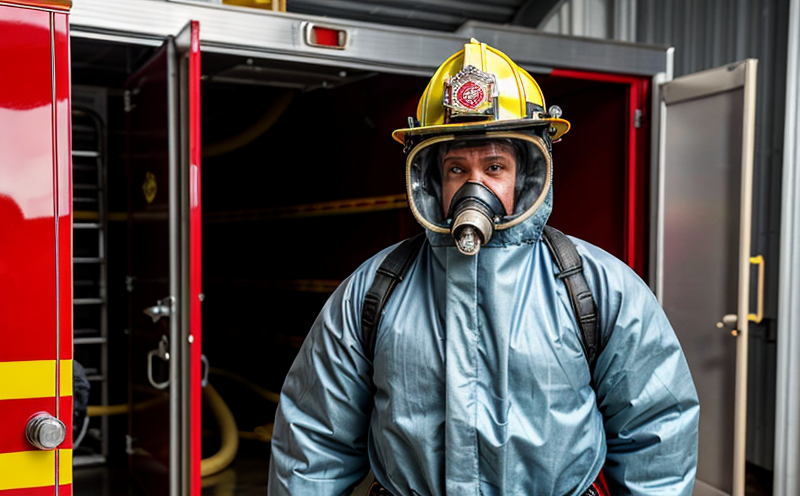Thermal Protective Performance (TPP) Testing
In fire safety testing, Thermal Protective Performance (TPP) Testing is a critical procedure used to evaluate the ability of firefighter protective clothing and equipment to protect the wearer from heat. This test measures how effectively the ensemble can withstand thermal exposure without compromising its integrity or allowing significant heat transfer through it.
The TPP Test is designed to simulate real-world conditions that firefighters might encounter during their duties, ensuring that the gear they rely on meets stringent safety standards. The primary objective of this testing is to safeguard the lives of firefighters by providing them with reliable protection against thermal hazards such as flames and hot environments.
The methodology involves exposing a sample of firefighter protective clothing or equipment to controlled heat sources under specified conditions. Various factors are considered, including the type of fabric used in the garment, its thickness, and the overall design of the ensemble. The test aims to determine if the material can prevent severe burns by limiting the amount of heat that reaches the skin.
The TPP rating is expressed as a value indicating the number of seconds it takes for a certain level of heat (typically 149°C) to penetrate through the fabric and reach the wearer's skin. A higher TPP value indicates better thermal protection, meaning less heat can pass through the material during an emergency situation.
For accurate results, specimen preparation is crucial. This includes ensuring that all seams are properly treated with flame-resistant sealants before testing begins. Preparing a representative sample size according to industry standards ensures consistency across multiple tests and comparisons between different products.
The equipment used for TPP Testing typically consists of a calorimeter or similar apparatus capable of delivering precise levels of heat exposure. In addition, sensors are embedded within the test samples to measure temperature changes accurately during the experiment. Compliance with international standards such as NFPA 1971 ensures uniformity and reliability in testing procedures worldwide.
It’s important to note that TPP Testing plays a vital role not only for manufacturers but also for regulatory bodies responsible for setting safety guidelines. By adhering strictly to these protocols, laboratories contribute significantly towards enhancing public safety by promoting the development of safer firefighting gear.
Scope and Methodology
The scope of TPP Testing encompasses several key areas that ensure both accuracy and consistency in evaluating thermal protective performance. This includes defining the exact parameters under which the test will be conducted, specifying the required apparatus needed for accurate measurement, detailing the procedures to follow during testing, and finally, outlining criteria used to interpret results.
- Test Specimens: Representative samples of firefighter protective clothing or equipment are selected based on their intended use. These may include helmets, boots, gloves, jackets, pants, etc., depending on the specific application being tested.
- Calorimeters: Advanced calorimetric devices capable of delivering controlled heat fluxes to simulate actual fire scenarios. These systems help maintain uniformity in testing conditions across various samples.
- Sensors: Embedded within the test specimens, these sensors monitor temperature increases during exposure to heat, providing real-time data on how effectively the material resists penetration by thermal energy.
The methodology follows strict protocols outlined in relevant standards like NFPA 1971 for North American markets or EN 469 for European Union countries. Compliance with these guidelines ensures that all tests are conducted under identical conditions, allowing for meaningful comparisons between different products and facilitating adherence to regulatory requirements.
Detailed procedures involve placing the test specimen in a calorimeter set at specific initial temperatures and heat fluxes. The duration of exposure is carefully controlled to simulate realistic fire exposures while minimizing damage to the material. Throughout this process, temperature readings are continuously recorded by embedded sensors until either 149°C or a predetermined time limit is reached.
After completing each test run, detailed reports summarizing all measurements and observations are generated. These documents provide comprehensive insights into the thermal protective performance of the evaluated items, helping manufacturers refine their designs and improve overall product quality.
Benefits
- Safety Enhancement: Ensures that firefighters have reliable protection against thermal hazards, reducing the risk of severe burns and injuries.
- Regulatory Compliance: Helps manufacturers meet stringent safety standards set by regulatory bodies worldwide, ensuring legal compliance.
- Product Improvement: Provides valuable data that can be used to enhance product design and performance continuously.
- Market Differentiation: Allows companies to demonstrate superior quality and reliability of their products, setting them apart from competitors in the market.
- Confidence Building: Builds trust among customers who know that they are investing in high-quality, safe equipment.
Use Cases and Application Examples
In the field of fire safety testing, TPP Testing has numerous applications across various scenarios faced by firefighters. For instance, it is commonly used to evaluate protective clothing worn during structural firefighting operations where prolonged exposure to intense heat is expected.
Another application involves assessing gloves and boots that protect hands and feet from direct contact with hot surfaces or flames. Such evaluations ensure that these items can provide adequate insulation even when exposed to extreme temperatures for extended periods without compromising their protective capabilities.
TPP Testing also plays a crucial role in developing new materials intended for use in firefighter protective clothing. By subjecting prototypes to rigorous testing, researchers and developers can identify optimal combinations of fabrics and designs that offer superior thermal protection while maintaining flexibility and comfort during wear.
In addition, this type of testing is instrumental in ensuring that personal protective equipment (PPE) remains effective throughout its lifecycle. Regular retesting helps maintain consistent performance levels over time, thereby extending the useful life of the gear without compromising safety standards.





